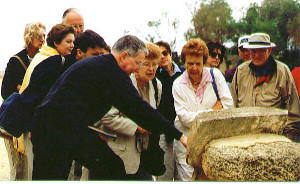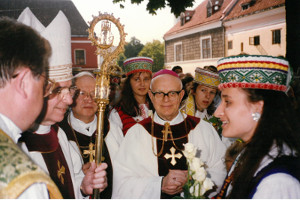Click the image below to explore FADICA’s Milestones:
The year 2016 marked the 40th anniversary of FADICA – a time to celebrate the impact our network of families and partners has made on Catholic philanthropy and to look ahead to the next decade of pioneering philanthropic leadership that responds to God’s call to serve.
The initiative to create FADICA came from the foundation community itself. A desire to fathom the rapid change within Catholicism following the Second Vatican Council combined with a trend of greater affluence among Catholics, set the stage for the community-building effort to link major philanthropists who have a religious focus.
Survey research commissioned by several private foundations verified the feasibility of creating a network for Catholic grantmakers. A working committee comprised of representatives of the Raskob Foundation for Catholic Activities, DeRance Foundation, Frank J. Lewis Foundation, Loyola Foundation, W. O’Neil Foundation, I.A. O’Shaughnessy Foundation, Robert Brunner Fund and Vatterott Foundation came together to create FADICA.
FADICA’s first annual meeting took place at the Palmer House Hotel in Chicago on May 26th 1976. The late John Bruderman, an investment advisor and foundation trustee of the Robert Brunner Foundation, served as the founding board chair of FADICA. Peter S. Robinson, FADICA’s founding president and member of the Raskob Foundation, pioneered FADICA’s first four years of programs and was responsible for the organization’s important formative years. In 1980, Francis J. Butler, a senior staff member at the United States Catholic Conference (now the USCCB), succeeded Peter Robinson and grew the organization from its original thirteen foundation three decades ago to nearly fifty members. Today the membership and programs continue to grow under the leadership of FADICA’s third President, Alexia K. Kelley, who assumed her leadership role in 2012.
FADICA has done its work in an era of profound change in American Catholic culture, defined in the past primarily by clergy, religious, parochial life and customs and now marked by explosive growth in lay activity and leadership. For over forty years, FADICA has gathered the most capable and talented scholars and church observers to help philanthropists interpret tends and assess what is needed to strengthen the faith community and advance its mission.


Although continuing education of the Catholic philanthropist remains at the heart of what FADICA does, it also takes pride in having facilitated a coming together of generous and highly-motivated people who work in partnership with the Catholic Church to offer concrete solutions to the pressing human and spiritual needs of our times.